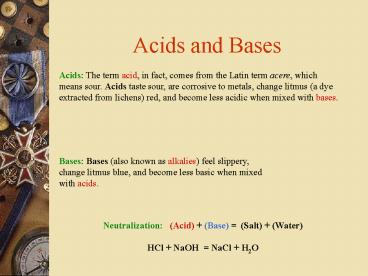Acids and Bases PowerPoint PPT Presentation
1 / 18
Title: Acids and Bases
1
Acids and Bases
Acids The term acid, in fact, comes from the
Latin term acere, which means sour. Acids taste
sour, are corrosive to metals, change litmus (a
dye extracted from lichens) red, and become less
acidic when mixed with bases.
Bases Bases (also known as alkalies) feel
slippery, change litmus blue, and become less
basic when mixed with acids.
Neutralization (Acid) (Base) (Salt)
(Water) HCl NaOH NaCl H2O
2
Where in the.S
What part of the tongue can taste a lemon or
other sour things?
http//www.miamisci.org/ph/phplumber.html
3
Answer
The green areas are where you would taste sour
foods such as a lemon.
4
Where in the.B
Where might you taste something bitter like
baking soda?
5
Answer
The green area is where you would taste bitter
foods such as baking soda.
This tells you how not to take those bitter pills.
6
Acid Rain
Acid rain is rain that has been made acidic by
certain pollutants in the air. Acid rain is a
type of acid deposition, which can appear in many
forms. Wet deposition is rain, sleet, snow, or
fog that has become more acidic than normal. Dry
deposition is another form of acid deposition,
and this is when gases and dust particles become
acidic. Both wet and dry deposition can be
carried by the wind, sometimes for very long
distances. Acid deposition in wet and dry forms
falls on buildings, cars, and trees and can make
lakes acidic. Acid deposition in dry form can be
inhaled by people and can cause health problems
in some people.
Lifted from EPA website
7
pH-Table EPA
http//www.epa.gov/acidrain/site_students/phscale.
html
8
pH-Table continued
Lemon Juice 4 Baking Soda 8 Aspirin 5 Ammonia
10 Milk of Magnesia 8 Lava Soap 10 Borax 9 W
ater 7 Lemon Soap 6 Vinegar 4 Tonic
Water 4 Liquid Plumber 12
http//www.miamisci.org/ph/phplumber.html
9
pH-Table
10
Indicators
Indicators-- An indicator is a special type of
compound that changes color as the pH of a
solution changes, thus Gives us an approximate
pH of the solution. Many dyes (chemicals) are
sensitive to hydrogen-ion concentration. Beyond
a certain threshold, they change visible color
and are used as indicators of the relative pH of
a solution.
Litmus paper - Paper with powder extracted from
certain plants that tests the pH of a substance.
Acid turns red while base turns blue neutral
remains white.
11
Phenolphthalein
- Phenolphthalein is a sensitive pH indicator with
the formula C20H14O4. Often used in titrations,
it turns from colorless in acidic solutions to
pink in basic solutions, the color change
occurring between pH 8 and pH 10. If the
concentration of indicator is particularly
strong, it can appear purple. - http//en.wikimedia.org/wiki/Phenophthalein
12
- Phenolphthalein is insoluble in water, and is
usually dissolved in alcohol for use in
experiments. - It is a colorless, weak acid, which can lose H
ions in solution. However, the phenolphthalein
ion is pink. When a base is added to the
phenolphthalein, the atom ? ion equilibrium
shifts to the ionization because H ions are
removed.
13
Other indicators
- Other indicators
- Indicator pH of change Color _at_ lower pH
Color _at_ higher pH - Methyl orange 4 Red Yellow
- Methyl red 5 Red Yellow
- Litmus 7 Red Blue
- Bromthymol blue 7 Yellow Blue
- Phenophthalein 9 Colorless Pink
- Alizarin yellow 11 Yellow Red
14
Make your own "litmus paper"
1. Chop the red cabbage up with a sharp knife.
2. Crush it with a "pestle and mortar" OR put it
in a food mixer and grind it. 3. Add a very
small amount of water. 4. Decant the blue liquid
(pour the liquid into a clean glass). 5. Soak
some blotting paper in the blue liquid. 6. Let
the blotting paper dry out. 7. Cut the blue
papers into small squares.
When you buy the red cabbage it is actually blue.
It will be quite blue when you slice it up and
add some tap water. That is because your tap
water is very slightly alkaline. If you add some
vinegar it will turn red. This is because there
is a pigment (coloured chemical) in the red
cabbage which acts as a pH indicator.
http//www.sambal.co.uk/indicators.html
15
Why is acid an acid?
All substances are made up of millions of tiny
atoms. These atoms form small groups called
molecules. In water, for example, each molecule
is made up of two hydrogen atoms and one oxygen
atom. The formula for a molecule of water is
H2O. "H" means hydrogen, "2" means 2 hydrogen
atoms, and the "O" means oxygen.
16
Why continued
When an acid is poured into water, it gives up H
(hydrogen) to the water. When a base is poured
into water, it gives up OH (hydroxide) to the
water.
Stronger acids give up more protons (the
positively charged parts of atoms) stronger
bases give up more OH- (hydroxide). Neutral
substances have an even balance of protons and
OH-.
17
Quantitative description of pH
pH - log10 H H hydrogen ion
concentration in units of moles of H per liter
of solution. For example, a solution with H
1 x 10-7 moles/liter has a pH 7 a solution
with H 1 x 10-6 moles/liter has a pH 6 A
simpler way to think about pH is that it equals
the exponent on the H concentration, ignoring
the minus sign).
Human sense organs work logarithmically!!
18
Further Study
EPA http//www.epa.gov/acidrain/site_students/wha
tisacid.html http//www.shodor.org/unchem/basic/a
b/water http//lrs.ed.uiuc.edu/students/erlinger
/water/background/ph.html

